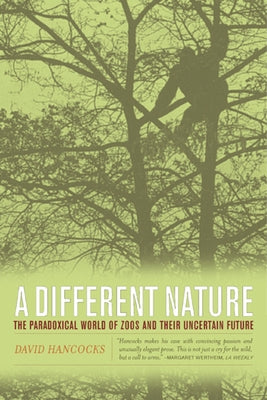Add to Wishlist
- Description
Description
Humanity has had an enduring desire for close contact with exotic animals-from the Egyptian kings who kept thousands of animals, including monkeys, wild cats, hyenas, giraffes, and oryx, to the enormously popular zoological parks of today. This book, the most extensive history of zoos yet published, is a fascinating look at the origins, evolution, and-most importantly-the future of zoos.
David Hancocks, an architect and zoo director for thirty years, is passionately opposed to the poor standards that have prevailed and still exist in many zoos. He reviews the history of zoos in light of their failures and successes and points the way toward a more humane approach, one that will benefit both the animals and the humans who visit them. This book, replete with illustrations and full of moving stories about wild animals in captivity, shows that we have only just begun to realize zoos' enormous potential for good.
Hancocks singles out and discusses the better zoos, exploring such places as the Arizona-Sonora Desert Museum, the Bronx Zoo with its dedication to worldwide conservation programs, Emmen Zoo in Holland with its astonishingly diverse education programs, Wildscreen in England, and Seattle's Woodland Park Zoo, where the concept of "landscape immersion"-exhibits that surround people and animals in carefully replicated natural habitats-was pioneered.
Calling for us to reinvent zoos, Hancocks advocates the creation of a new type of institution: one that reveals the interconnections among all living things and celebrates their beauty, inspires us to develop greater compassion for wild animals great and small, and elicits our support for preserving their wild habitats.
Author: David Hancocks
Publisher: University of California Press
Published: 01/01/2003
Pages: 301
Binding Type: Paperback
Weight: 0.90lbs
Size: 9.00h x 6.00w x 0.90d
ISBN13: 9780520236769
ISBN10: 0520236769
BISAC Categories:
- Nature | Environmental Conservation & Protection | General
- Science | Life Sciences | Zoology | General
David Hancocks, an architect and zoo director for thirty years, is passionately opposed to the poor standards that have prevailed and still exist in many zoos. He reviews the history of zoos in light of their failures and successes and points the way toward a more humane approach, one that will benefit both the animals and the humans who visit them. This book, replete with illustrations and full of moving stories about wild animals in captivity, shows that we have only just begun to realize zoos' enormous potential for good.
Hancocks singles out and discusses the better zoos, exploring such places as the Arizona-Sonora Desert Museum, the Bronx Zoo with its dedication to worldwide conservation programs, Emmen Zoo in Holland with its astonishingly diverse education programs, Wildscreen in England, and Seattle's Woodland Park Zoo, where the concept of "landscape immersion"-exhibits that surround people and animals in carefully replicated natural habitats-was pioneered.
Calling for us to reinvent zoos, Hancocks advocates the creation of a new type of institution: one that reveals the interconnections among all living things and celebrates their beauty, inspires us to develop greater compassion for wild animals great and small, and elicits our support for preserving their wild habitats.
Author: David Hancocks
Publisher: University of California Press
Published: 01/01/2003
Pages: 301
Binding Type: Paperback
Weight: 0.90lbs
Size: 9.00h x 6.00w x 0.90d
ISBN13: 9780520236769
ISBN10: 0520236769
BISAC Categories:
- Nature | Environmental Conservation & Protection | General
- Science | Life Sciences | Zoology | General
About the Author
David Hancocks lives in Melbourne, Australia. He is Director of the Open Range Zoo, at Werribee, and Director of Planning for the Zoological Parks and Gardens Board, Victoria, Australia. He is author of Animals and Architecture (1971) and Master Builders of the Animal World (1973).




